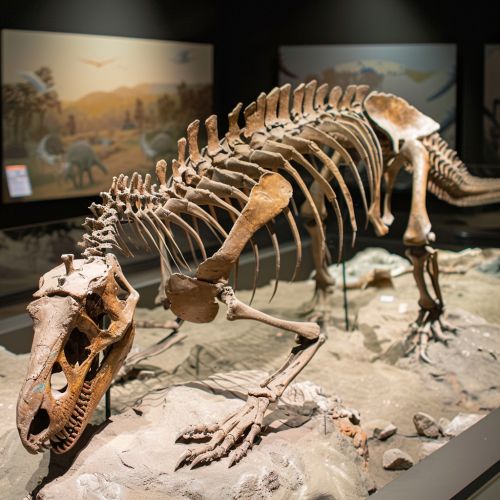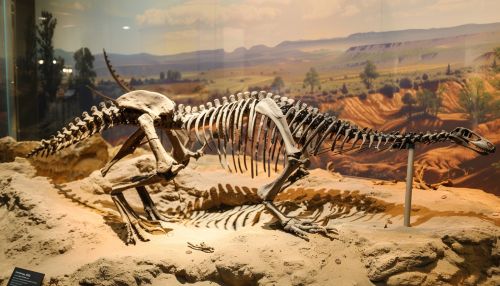Aetosaurs
Introduction
Aetosaurs are an extinct group of heavily armored, herbivorous archosaurs that lived during the Late Triassic period, approximately 237 to 201 million years ago. These reptiles are characterized by their distinctive body armor, elongated snouts, and herbivorous diet. They are part of the larger clade Pseudosuchia, which also includes modern crocodilians and their extinct relatives. Aetosaurs are known from fossil remains found on nearly every continent, indicating a wide distribution during their time.
Taxonomy and Classification
Aetosaurs belong to the order Aetosauria, which is part of the clade Pseudosuchia within the larger group Archosauria. Archosauria also includes the clade Avemetatarsalia, which encompasses dinosaurs and modern birds. The classification of aetosaurs has been refined over the years through detailed studies of their morphology and phylogenetic relationships.
Families and Genera
Aetosaurs are divided into several families, with the most well-known being Stagonolepididae. This family includes genera such as Desmatosuchus, Stagonolepis, and Aetosaurus. Each genus exhibits unique features in their armor and skeletal structure, which have been crucial for paleontologists in understanding their evolutionary relationships.
Morphology
Aetosaurs are easily recognizable by their distinctive body armor, which consists of rows of osteoderms—bony plates embedded in the skin. These osteoderms provided significant protection against predators and may have played a role in thermoregulation.
Skull and Dentition
The skulls of aetosaurs are elongated with narrow snouts, adapted for their herbivorous diet. Their teeth are small and leaf-shaped, suitable for processing plant material. Unlike many other archosaurs, aetosaurs lack the sharp, conical teeth typical of carnivorous species.
Postcranial Skeleton
The postcranial skeleton of aetosaurs is robust, with strong limbs adapted for a terrestrial lifestyle. Their vertebral column is reinforced by the presence of osteoderms, which extend from the neck to the tail. The limbs are relatively short but powerful, indicating that aetosaurs were likely slow-moving but capable of digging or rooting through vegetation.
Paleoecology
Aetosaurs inhabited a variety of environments during the Late Triassic, including floodplains, river valleys, and arid regions. Their widespread distribution suggests they were highly adaptable and could thrive in different ecological niches.
Diet
As herbivores, aetosaurs primarily fed on low-lying vegetation, including ferns, cycads, and other Triassic flora. Their specialized teeth and jaw structure allowed them to efficiently process plant material. Some evidence suggests they may have also consumed insects or small invertebrates, but this is considered secondary to their primary herbivorous diet.
Behavior
The behavior of aetosaurs is inferred from their morphology and fossilized trackways. Their heavy armor and robust limbs suggest they were slow-moving and relied on their osteoderms for protection. Trackways indicate that they moved in a sprawling gait, similar to modern crocodilians.
Fossil Record
Aetosaurs have a rich fossil record, with remains found in North America, South America, Europe, Africa, and Asia. Some of the most well-preserved specimens have been discovered in the Chinle Formation of the southwestern United States and the Ischigualasto Formation in Argentina.
Notable Discoveries
One of the most significant aetosaur discoveries is the genus Desmatosuchus, known for its large, spiked osteoderms. Another important find is Stagonolepis, which has provided valuable insights into the diversity and evolution of aetosaurs.


Evolutionary Significance
Aetosaurs are important for understanding the evolutionary history of archosaurs, particularly the divergence between Pseudosuchia and Avemetatarsalia. Their unique adaptations and widespread distribution provide insights into the ecological dynamics of the Late Triassic period.
Phylogenetic Relationships
Phylogenetic studies have placed aetosaurs within Pseudosuchia, closely related to other armored archosaurs such as Rauisuchians. Their relationships with other Triassic archosaurs have been elucidated through detailed analyses of their osteoderms and skeletal features.
Extinction
Aetosaurs, like many other Triassic reptiles, went extinct at the end of the Triassic period. This extinction event, known as the Triassic-Jurassic extinction event, was one of the major mass extinctions in Earth's history. It led to the decline of many archosaur groups and paved the way for the rise of dinosaurs in the Jurassic period.
